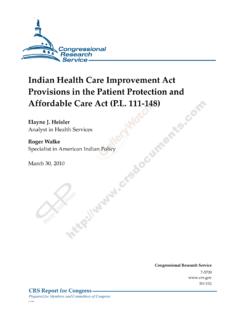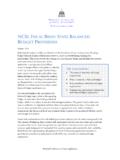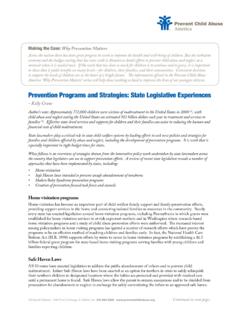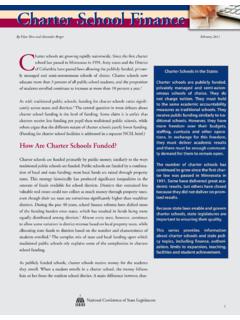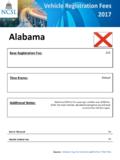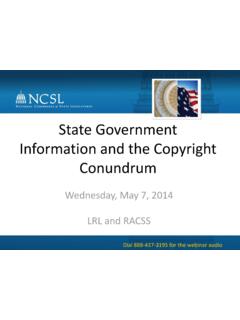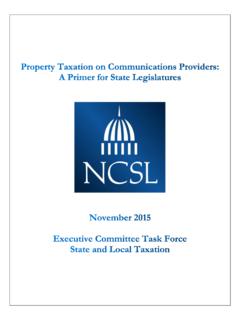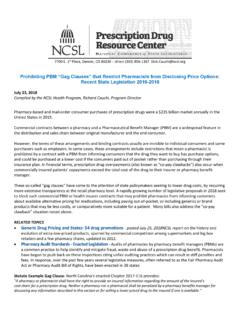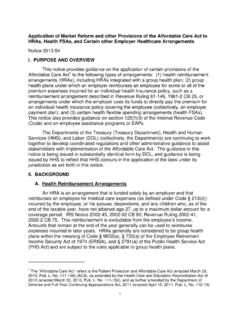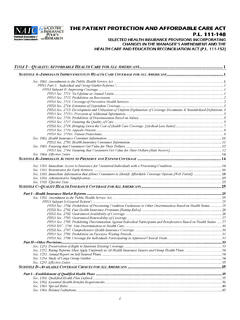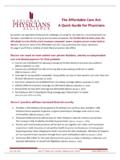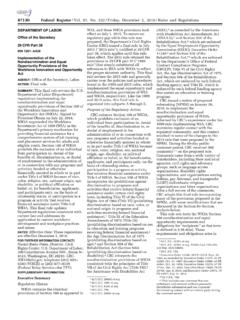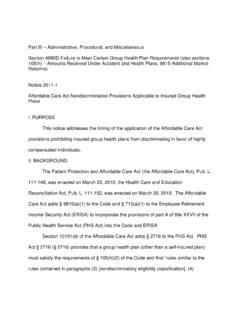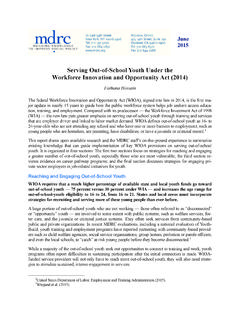Transcription of ACA Requirements for Medium and Large …
1 ACA Requirements for Medium and Large Employers to Offer Health Coverage Applicable in part to states, state legislatures and local governments as employers Compiled by Richard Cauchi, NCSL Health Program Updated edition: June 22, 2016 The federal Affordable Care Act (ACA) includes a requirement that most Large employers must offer health insurance. The implementation of this broad provision depends on a combination of federal statute, agency regulations and plain language guidance, including exemptions, postponed deadlines, promulgated and announced during 2012 to 2015.
2 These substantive policy changes have an impact on states and employers in every region. Q - Do the Employer Shared Responsibility provisions apply to government entities? A Yes. There is no exclusion from the Employer Shared Responsibility provisions for government entities. All employers that are applicable Large employers are subject to the Employer Shared Responsibility provisions, including federal, state, local, and Indian tribal government employers. (Source: Q & A, #8 by IRS, reviewed Mar. 2, 2016) The majority of the information within this memo is excerpted from guidance and regulations from the Department of Health and Human Services (HHS), the Treasury Department and the Department of Labor.
3 This memo focuses on issues that may be applicable to state legislatures as employers. However, the exact size and structure of distinct employment units within state government can affect Requirements , such as the actual number of full time equivalent (FTE) positions. Large employers with 100 or more employees (about 2 percent of employers): The ACA requires that Large employers, defined as those with 100 or more full-time or full time equivalent (FTE) employees, must offer health insurance or coverage beginning January 1, 2015. This postponed the requirement by one year from the original date January 1, 2014 and was announced July 2, 2013 and modified in February 2014, as described below.
4 The majority of companies with 100 or more employees already offer quality health coverage to their employees 2015-16 Action Required: Revised rules phase in the percentage of full-time workers for whom employers need to offer coverage from 70 percent in 2015 to 95 percent in 2016 and beyond. Employers in this category that do not meet these standards will make an employer responsibility payment for 2015. The offered insurance must meet the minimum essential coverage (MEC) requirement, a once a year determination. Medium -sized employers with 50 employees to 99 employees (about 2 percent of employers): Those employers that do not yet provide quality, affordable health insurance to their full-time workers were required to report to the Treasury Department on their workers and coverage in 2015, but had until 2016 before any employer responsibility payments could apply.
5 Companies with 50 to 99 FTE employees include about 7 percent of the private workforce. 2015-16 Action Required: These employers must offer health insurance or coverage beginning January 1, 2016. On Feb. 10, 2014, the Treasury Department postponed by one additional year the original requirement that employers with between 50 to 99 workers meet the mandate to offer health insurance. The new rules also require 70 percent of workers to be covered in 2016, the first year of implementation. Small businesses with fewer than 50 employees (about 96 percent of all employers): Under the Affordable Care Act, employers that have fewer than 50 employees are not required to offer or provide coverage or fill out detailed forms under the Affordable Care Act.
6 Small Employer Health Care Tax Credit: The law also assists some small businesses and small tax-exempt organizations afford the cost of covering their employees health insurance. If a small business has fewer than 25 employees and provides health insurance it may qualify for a small business tax credit of up to 50 percent (up to 35 percent for non-profits) to offset the cost of insurance, starting with the 2014 federal tax year. See IRS explanation of tax credit Small Business Health Care Tax Credit and the SHOP Marketplace (Updated Jan.)
7 6, 2016) Small Business Health Options Program (SHOP): Small business exchanges have a framework set by federal rules, including options for how employers can provide contributions toward employee coverage that meet standards for small business tax credits. SHOP Exchanges are designed to serve as a marketplace for small employers with one to 100 workers, or up to 50 workers if a state chooses that approach. HHS: for small business; HHS: Overview and explanations Read the Treasury Department Descriptions: 1. Fact Sheet for Employers.
8 Online (3 pp.; updated Sep. 2, 2015) 2. Questions and Answers on Employer Shared Responsibility Provisions Under the Affordable Care Act. (56 questions, updated Mar. 2, 2016) See: 3. Final Regulations, (Effective Feb. 12, 2014) 59 pp., online. NCSL Report: Small and Large Business Health Insurance: State & Federal Roles. (Updated June 22, 2016) See: Employer Requirements to Offer Coverage Medium and Large Employers (with 50 or more full time employees [FTEs]) [Note delayed deadlines, announced July 2, 2013 and Feb 10, 2014 by the Treasury Department] Employers with 50 or more employees, including for-profit, non-profit and government entity employers, generally are required to offer health insurance to each full-time employee.
9 For 2015 and after, employers employing at least a certain number of employees (generally 50 full-time employees or a combination of full-time and part-time employees that is equivalent to 50 full-time employees) will be subject to the Employer Shared Responsibility provisions under section 4980H of the Internal Revenue Code (added to the Code by the Affordable Care Act). As defined by the statute, a full-time employee is an individual employed on average at least 30 hours of service per week. An employer that meets the 50 full-time employee threshold is referred to as an applicable Large employer.
10 Under the Employer Shared Responsibility provisions, if these employers do not offer affordable health coverage that provides a minimum level of coverage to their full-time employees (and their dependents), the employer may be subject to an Employer Shared Responsibility payment if at least one of its full-time employees receives a premium tax credit for purchasing individual coverage on one of the new Affordable Insurance Exchanges, also called a Health Insurance Marketplace (Marketplace). For employers with 50 to 99 FTEs, this requirement was delayed for two years, to January 1, 2016, based on Treasury Department rules released Feb 10, 2014.
